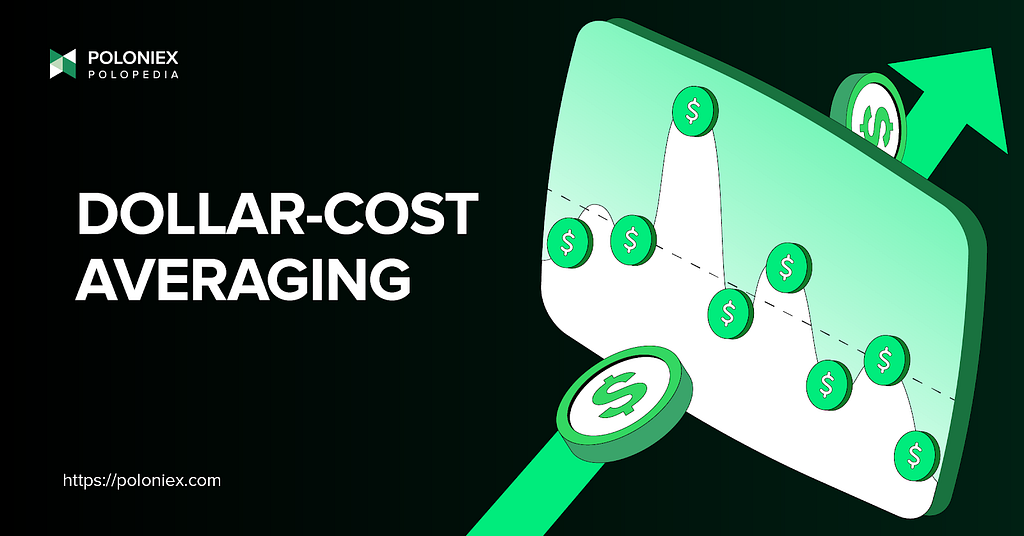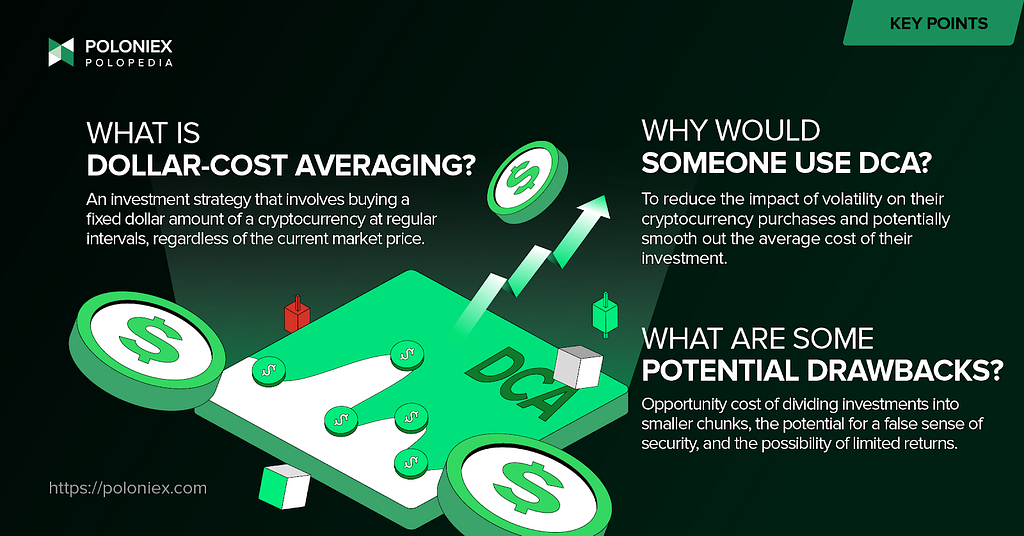Latest news about Bitcoin and all cryptocurrencies. Your daily crypto news habit.

TL;DR
Dollar-cost averaging is an investment strategy wherein an investor buys the same amount of a cryptocurrency over the course of time at regular intervals. Potential upsides include reducing market volatility’s impact on investments and building up a larger position over time. However, there is a possible opportunity cost associated with this tactic.

What is dollar-cost averaging?
Dollar-cost averaging, or DCA, is an investment strategy that involves buying a fixed dollar amount of a cryptocurrency at regular intervals, regardless of the current market price. The goal of DCA is to reduce the impact of volatility on the overall cost of purchasing the cryptocurrency, by allowing the investor to spread out their purchases over time. This can potentially smooth out the average cost of the investment and reduce the negative impact of making a poorly timed purchase. Dollar-cost averaging does not guarantee a successful investment and does not eliminate risk, but it may be a useful strategy for investors who want to gradually build a position in a cryptocurrency over an extended period of time.
Why would someone use dollar-cost averaging?
There are several reasons why an investor might choose to use DCA:
To reduce risk: One of the primary benefits of DCA is that it can help to reduce the risk of making a poorly timed investment. This is because DCA allows investors to spread out their purchases over time, rather than committing all of their money at once. This can reduce the impact of market volatility on the overall return of the investment.
To avoid market timing: Market timing, or trying to predict the best time to buy or sell an asset, is extremely difficult and often leads to poor results. DCA eliminates the need to try to accurately time the market, as the strategy makes the investment decisions for you.
To make regular investing easier: For many people, it can be difficult to come up with a large sum of money all at once. By using DCA, investors can invest smaller amounts of money at regular intervals, which may be more manageable for their financial situation.
To take advantage of dollar-cost averaging’s long-term benefits: While DCA does not guarantee a successful investment, the long-term benefits of DCA are well-documented. Studies have shown that DCA can lead to better returns than investing a lump sum all at once, especially in volatile markets.
Dollar-cost averaging example
To see this trading method in practice, let’s consider an example: Imagine you want to invest a set amount of $2,000 in Ethereum (ETH). You believe that the price will remain relatively stable in the short-term, so you decide to use dollar-cost averaging to gradually build your position.
To do this, you divide your $2,000 into smaller chunks of $100 and plan to purchase $100 worth of ETH every week for the next month. This way, you can spread out your investments and potentially reduce the impact of volatility on your purchases.
Now, let’s say that ETH has recently entered a bear market and you don’t expect a bull trend to occur for at least the next couple of years. However, you still believe that the market will eventually recover and want to prepare in advance.
In this case, you may want to adjust your DCA strategy. Since your investment has a much longer time horizon, you need to be prepared to hold onto your funds for a few years. One option could be to divide your $2,000 into 20 equal chunks of $100 and purchase $100 worth of ETH every month for the next two years.
This approach allows you to build up a long-term position while the bear market plays out. You won’t miss the opportunity to enter the market when the bull trend eventually starts.
Potential disadvantages
Dollar-cost averaging is not a risk-free investment strategy. Some potential drawbacks or risks to consider include the opportunity cost of dividing investments into smaller chunks and making purchases over a longer period of time, which may result in missing out on opportunities to buy at lower prices.
In addition, the strategy assumes that the market will remain relatively stable over the investment period, but if the market experiences significant volatility or a sudden downturn, your investments may still be negatively impacted. Dollar-cost averaging can help reduce the influence of emotions on investment decisions, but it may also lead to a false sense of security and may not be suitable for investors who do not regularly monitor their investments.
Finally, this strategy may limit your potential returns if the asset you are investing in experiences a rapid increase in value, as you may not have enough funds available to take advantage of the increase. It is important to carefully consider these risks and potential drawbacks before implementing a dollar-cost averaging strategy, and to ensure that this approach aligns with your financial goals and risk tolerance.
Disclaimer
The views and opinions expressed in this article are solely those of the authors and do not reflect the views of Bitcoin Insider. Every investment and trading move involves risk - this is especially true for cryptocurrencies given their volatility. We strongly advise our readers to conduct their own research when making a decision.